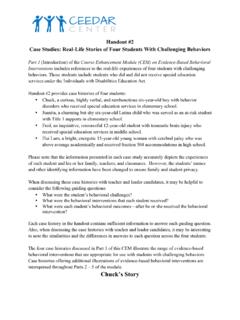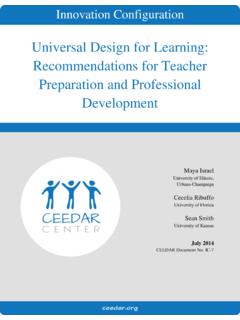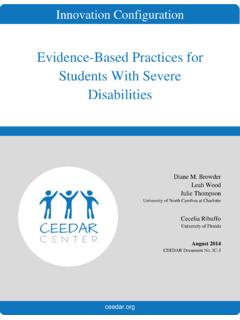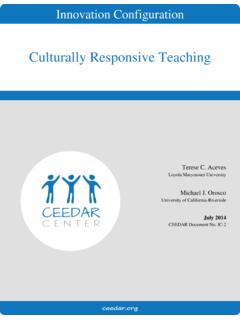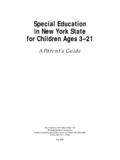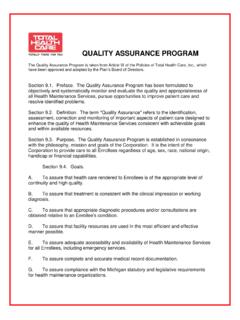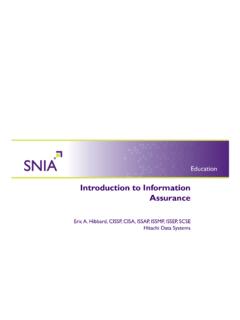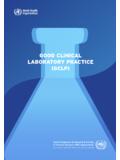Transcription of #17014 CEC High-Leverage Practices - CEEDAR
1 CEEDARHigh-Leverage Practices in special EducationJames McLeskey (Chair)University of FloridaMary-Dean BarringerCouncil of Chief State School OfficersBonnie BillingsleyVirginia Polytechnic Institute and State UniversityMary BrownellUniversity of FloridaDia JacksonAmerican Institutes for ResearchMichael KennedyUniversity of VirginiaTim LewisUniversity of MissouriLarry MaheadySUNY Buffalo StateJackie RodriguezWilliam & MaryMary Catherine ScheelerThe Pennsylvania State UniversityJudy Winn University of Wisconsin-MilwaukeeDeborah ZieglerCouncil for Exceptional ChildrenJanuary 2017 The HLP Writing Team 2017 by Council for Exceptional Children & CEEDAR for Exceptional Children 2900 Crystal Drive, Suite 100 Arlington, VA 22202-3557 is granted to reproduce and adapt any portion of this publication with acknowledgment. Reference:McLeskey, J., Barringer, M-D., Billingsley, B., Brownell, M., Jackson, D.
2 , Kennedy, M., Lewis, T., Maheady, L., Rodriguez, J., Scheeler, M. C., Winn, J., & Ziegler, D. (2017, January). High-Leverage Practices in special education. Arlington, VA: Council for Exceptional Children & CEEDAR document was supported from funds provided by the CEEDAR Center (Collaboration for Effective Educator, Development, Accountability and Reform) cooperative grant supported by the Office of special Education Programs (OSEP) of the Department of Education (H325A120003). Drs. Bonnie Jones and David Guardino served as the project officers. The views expressed herein do not necessarily represent the positions or policies of the Department of Education. No official endorsement by the Department of Education of any product, commodity, or enterprise mentioned in this document is intended or should be of Congress Cataloging-in-Publication data Council for Exceptional Children and CEEDAR Center.
3 High-Leverage Practices in special education: Foundations for student success. p. cm. Includes biographical 978-0-86586-526-6 (soft cover)ISBN 978-0-86586-527-3 (eBook)Stock No. P6255 Cover and layout by Tom Karabatakis, TomPromo MarketingPrinted in the United States of America by Bradford & BigelowFirst edition 10 9 8 7 6 5 4 3 2 1 ContentsPreface 1 Introduction 7 High-Leverage Practices for K 12 special Education Teachers 15 Research Syntheses: Collaboration High-Leverage Practices 27 Research Syntheses: Assessment High-Leverage Practices 41 Research Syntheses: Social/Emotional/Behavioral High-Leverage Practices 55 Research Syntheses: Instruction High-Leverage Practices 69 Appendix: Glossary of Terms and Related Resources 117 1 PrefaceSpecial education teachers, as a significant segment of the teaching profession, came into their own with the passage of Public Law 94-142, the Education for All Handicapped Children Act, in 1975.
4 Since then, although the number of special education teachers has grown substantially it has not kept pace with the demand for their services and expertise. The roles and practice of special education teachers have continuously evolved as the complexity of struggling learners unfolded, along with the quest for how best to serve and improve outcomes for this diverse group of students. As this complexity was addressed, those preparing special education teachers found themselves responding to conflicting external forces. New content was added to preparation programs to meet requirements of professional accreditation groups, changing state licensure requirements, and federal regulations related to teacher preparation. These programs also needed to respond to the long-term shortage of special education teachers, with intensive and rapid preparation of highly qualified teachers although there was no clear guidance as to the most effective Practices to target.
5 Without clarity regarding the Practices and expertise that define an effective special educator, this role began to be viewed by potential teachers as less desirable than other teaching assignments despite the clear need and job , research continued to establish evidence regarding Practices that could make a positive difference with students who were struggling to find success in school because of learning and behavioral complexities. What was needed was guidance as to the most important of these Practices that special educators needed to learn to use in classrooms clear signals among the noise of demands placed on teacher education programs. Development of the High-Leverage Practices in special EducationIn fall 2014, the Board of Directors of the Council for Exceptional Children (CEC) approved a proposal from the CEC Professional Standards and Practice Committee (PSPC) to develop a set of High-Leverage Practices (HLPs) for special education teachers.
6 The PSPC, the Teacher Education Division (TED) of CEC, and the CEEDAR Center at the University of Florida endorsed this project. The CEEDAR Center, which is funded by the Department of Education s Office of special Education Programs, provided a sub-award to CEC to 2 High-Leverage Practices in special Educationsupport this work. The HLP Writing Team s 12 members included representatives from CEC s PSPC, TED, the CEEDAR Center, the Council of Chief State School Officers, and CEC staff. In addition, seven CEC members were selected from over 50 nominations that were received from the PSPC, TED, and the CEEDAR Center. This team of prac-titioners, scholars, researchers, teacher prep-aration faculty, and advocates knew that to achieve the project s intended purposes, they needed to ensure that the results of their work established the need to improve teacher preparation programs, provided a rationale both for developing practice-based teacher preparation programs and for the HLPs themselves, and explained how the HLPs could be used to support student fundamental purpose of CEC s HLP project was to identify improved methods for supporting special education January 2015 March 2015 HLP Writing Team develops a draft list of HLPsFigure 1.
7 Development of CEC s High-Leverage Practices in special EducationHLP Writing Team finalizes the draft list of HLPsApril 2015 Summer-Fall 2015 October 2015 November 2015 January 2016 April 2016 July 2016 Focus group interviews held at CEC Convention in San Diego, CA: 2 focus group sessions, one with a group of teacher educators and one with a group of special education teachersAdditional focus group interviews with teachers, special education administrators and trainers of administrators, and CEC division leaders who were teacher educators in programs preparing teachers of students with severe and low-incidence disabilities. Feedback summarized and shared with HLP Writing TeamDraft HLPs completed Draft shared with CEC Teacher Education Division (TED); feedback received via an online surveyHLP Writing Team meets to incorporate feedbackFinal draft presented to CEC Board of DirectorsDraft HLPs presented to CEC Representative Assembly (RA) at CEC Convention in St.
8 Louis, MO. 3 Prefaceteacher candidates as they learn to use effective Practices in their classrooms. Although effective teaching Practices had previously been identified, these mainly comprised undifferentiated, overall lists with brief descriptions of each practice ( , ). Figure 1 describes the development of the HLPs. The HLP Writing Team spent con-siderable time determining the group of special educators to whom the HLPs would apply. It was the perspective of the HLP Writing Team that a high-quality set of HLPs could be developed that directly applied to the classroom Practices of teachers in K 12 settings, although a separate set of HLPs could be developed to more specifi-cally address the particular Practices used by teachers of students with gifts and tal-ents.
9 CEC s Division for Early Childhood has developed DEC Recommended Practices (2015), which provides guidance to practi-tioners and families about the most effec-tive ways to improve the learning outcomes and development of young children, birth through age 5, who have or are at risk for developmental delays or HLPs are organized around four aspects of practice collaboration, assess ment, social/emotional/behavioral Practices , and instruction because special education teachers enact Practices in these areas in integrated and reciprocal ways. For example, special education teachers use assessment to design instruction and then evaluate it. The HLPs for instruction can be used to teach both academic content and emotional, behavioral, and social skills; special educa-tion teachers bring their knowledge of HLPs in these areas to collaboration with other professionals and parents.
10 The integrated and recursive use of HLPs in these four areas results in some overlap at times; for example, to learn to use the collaboration HLPs in practice requires teachers to have a deep know ledge of Practices related to each of the other three areas. Similarly, using assess-ment data to make instructional decisions is a critical component of both effective instruction and effective assessment. Providing effective feedback appears in both the social/emotional/behavioral Practices HLPs and the instruction HLPs; two research syntheses were developed as the basis for this item. Organizing the HLPs in this way was intended to make them more comprehensible and easier to use in planning core components of a practice-based teacher preparation program.
